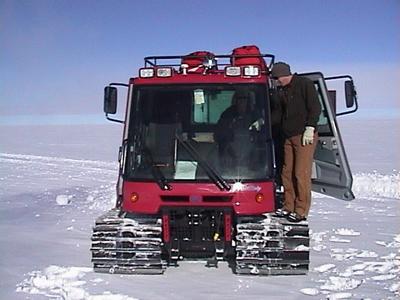msolga wrote:dlowan wrote:msolga wrote:patiodog wrote:Sounds awful.
What a wet blanket!
It sounds fabulous, patiodog!
Now,
you are a qualified medical person of some sort, aren't you? :wink:
He's not a husky. They have special fur round their bums for sitting on the snow. Patio would get cold.
Also, they don't have dogs down there any more.
Too much pooh and such.

OK, patio's out then.
A pity.
So the search continues .....
No huskies because of the pooh? I didn't know that.
So how do they get around the place these days, then?
Some sort of motorized contraptions?
Yep.
Last husky was taken out at least ten years ago.
Here we go:
Not so natural: huskies in Antarctica
Husky with pup
Photo: Alan Wilkinson
Huskies were first used in the Antarctic by the British Antarctic Expedition of 1898-1900. They were strong and willing workers.
Coming from Greenland and Labrador they were familiar with snow, ice, cold and wind. Their thick double-layered coats provided excellent protection against the extremely cold conditions. The huskies wore harnesses and could haul from fifty up to ninety kilograms. Normally working in teams, the number of dogs used varied depending on the weight of the load to be hauled.
The term husky is usually used to refer to snow or northern hemishere dogs and can include a wide range of breeds.
In 1954 when Australia established its first permanent Antarctic station at Mawson huskies were introduced. This continued to be their home for almost 40 years.
In addition to being a reliable form of transport, the huskies provided companionship, love and loyalty to the Antarctic expeditioners. This loyal and hard working animal continues to evoke strong emotion in young and old alike.
The 1991 Protocol on Environmental Protection to the Antarctic Treaty banned all introduced species, except man, from being taken into the Antarctic. It was with a great deal of sadness that in 1993 the last remaining huskies left Mawson and the Australian Antarctic Territory. The older dogs are living out their days in Australia, the younger, working dogs are enjoying a new life in Minnesota, USA.
It weren't all beer and skittles:


msolga wrote:
So how do they get around the place these days, then?
Some sort of motorized contraptions?


weather fine and clear at Mawson, Davis, Casey bit windy and overcast
http://www.aad.gov.au/asset/webcams/davis/default.asp
That makes sense, Deb.
... and as I recall, from an article I read a while back, accumulated pollution as a result of human habitation the Antarctic has become a big problem, too.
A chap I know went to the antarctic for a 6 month? tour of duty some years ago. He was/is on the staff at Timbertop. Geelong Grammer schools mountain campus.
And our/my doctor went to africa as a volunteer for 12 months. Ogranised for all our school kids to send over broken/used coloured pencils. The children over there had never seen coloured pencils and were thrilled.
Crikey.
I admit I'm no expert in these things, but those heavy vehicles look like they'd produce
their share of pollution, too, dadpad!
And do a bit of damage to the environment at the same time.
A movie I saw quite a while ago...
Taro and Jiro in Antarctica
http://en.wikipedia.org/wiki/Nankyoku_Monogatari
They left 15 huskies chained up & no one could return there for 4 years?
Terrible.
According to wiki, the dog handler returned a year later to give the dogs a decent burial.
They hadn't figured on not being able to return to the dogs, as I remember. The dogs had food for a week...
I read the memoir of the doctor with breast cancer--we had breast cancer at the same time. Because South Pole Scientists tend to be vigorous people, the Physician on Site doesn't have too many medical problems.
Therefore, the Doctor is also a one-person committee for combatting boredome--Chief Recreational Officer.
NASA studies Polar Outposts to get some idea of the stresses that happen when highly intelligent humans are locked up together with No Exit.
ossobuco wrote:According to wiki, the dog handler returned a year later to give the dogs a decent burial.
They hadn't figured on not being able to return to the dogs, as I remember. The dogs had food for a week...
That's right, osso. (According the your Wikipedia link)
And apparently two of the dogs survived!